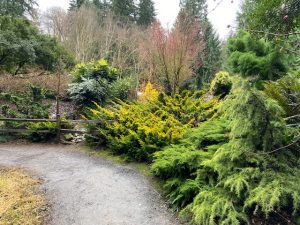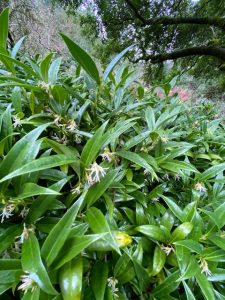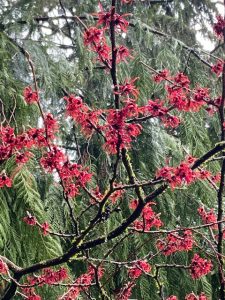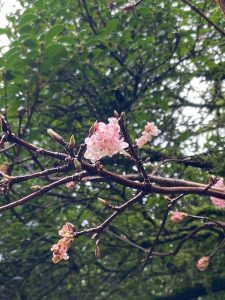These mornings when I start out on the trail, the air seems fresher. Spring is on the way even with the recent snow! But, regardless of the forecast, it’s time to see the Hoyt Arboretum’s Winter Garden.
I’m so impressed with the thought that went into both the location of the Winter Garden – where it is in the Arboretum, and its design – and how it looks. The garden is at the intersection of several trails, including the Wildwood Trail and the northern ends of the Magnolia and Beech Trails. A small parking area on SW Cascade Drive allows for those with limited mobility to view the garden, either from car windows or from short level trails.

The access to the Winter Garden from SW Cascade Drive is marked by a grove of Himalayan birch (Betula utilis), which exhibit the lovely white, peeling bark characteristic of this species. The Himalayan birch has the whitest bark of the white-barked birches. The canoe, or paper, birch (Betula papryifera) of canoe-making fame is the most distinctive North American species. Birches are generally small to medium, quick-growing, short-lived trees that are frequently the first species to grow on disturbed or open sites, where they are native. They may also be “nitrogen-fixers”- in that some birch species can improve soil fertility due to a symbiotic relationship with soil bacteria. I was surprised to discover that most of the birches in the Winter Garden grove were planted in different years.
Hoyt Arboretum’s Winter Garden is designed to be especially interesting in winter by displaying not only winter-flowering plants, but also small-scale evergreen shrubs with interesting foliage color and texture, and small deciduous trees and shrubs with unusual bark colors or branching patterns that can only be appreciated when the leaves are off the plants. Currently, at the ground level, the hellebores (Lenten roses) are blooming and provide a full range of flower colors from greenish-yellow to deep purple. Evergreen sarcococca or sweetbox (Sarcococca hookeriana var. humilis) has just finished or is about to bloom, with many tiny white flowers that are wonderfully fragrant. I spied three varieties of Sasanqua camellias in bloom – one with a double pink flower and “single-flower” varieties with red and white flowers.

While I was so busy looking down at the ground level species, I almost missed the several shrubs that are blooming: Witch-hazel (Hamamelis x intermedia ‘Diane’), with flowers that resemble little fireworks explosions on bare branches and have a sweet scent, and Edgeworthia (Edgeworthia chrysantha), the paper bush, a shrub with showy clusters of small white, yellow or pink-blush flowers on branch tips. Note to self: Remember to look up! And stop to smell the flowers – these winter-flowering species are surprising with their wonderful scent.


A visit to the Winter Garden is always interesting but now is the time to see it at its wintery best, even covered in snow. In every season, as I wander through Hoyt Arboretum on the trails, I always find plants that inspire me, intrigue me, maybe even talk to me about what is happening in their lovely arboretum home, and the Winter Garden is unlike any other plant collection at Hoyt Arboretum.
About the Author
 Claire Carder volunteers as a Naturalist at Hoyt Arboretum. A retired environmental project coordinator, she worked to promote landscaping with native plants and ecological restoration. She resides in Southwest Portland, where she loves to hike and jog the trails of Hoyt Arboretum and Forest Park and go on long neighborhood rambles.
Claire Carder volunteers as a Naturalist at Hoyt Arboretum. A retired environmental project coordinator, she worked to promote landscaping with native plants and ecological restoration. She resides in Southwest Portland, where she loves to hike and jog the trails of Hoyt Arboretum and Forest Park and go on long neighborhood rambles.
